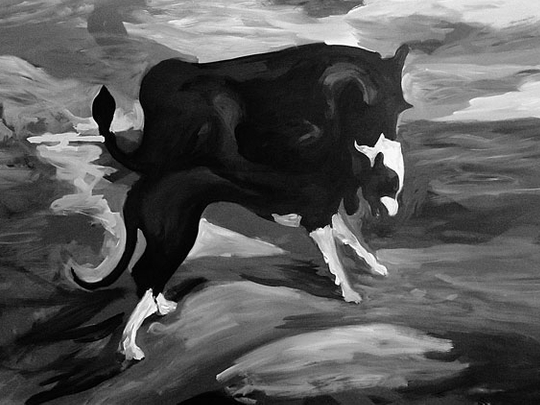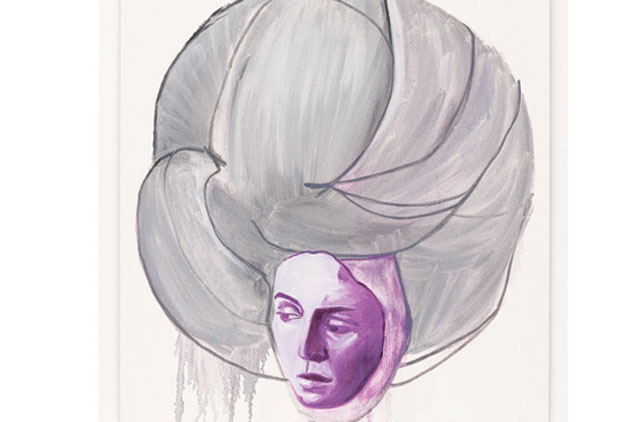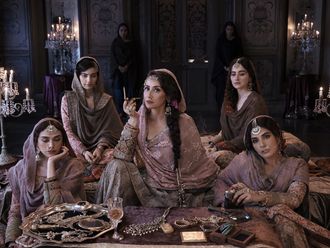
Tom Ellis, Dan Perfect, Tasha Amini and Petroc Sesti belong to a new generation of British artists redefining contemporary British art. They combine classical traditions with modern technology and typical British eccentricity with a global perspective to create their individual artistic vocabularies. The young artists are showcasing their work for the first time in this region in a joint exhibition, New Wave — British Art Today. With artworks ranging from thought-provoking paintings and photographs to stunning fluid glass sculptures, the show brings a refreshing flavour of cutting-edge British art to Dubai.
Ellis's work deals with the mechanism of culture production in a media-driven society. He employs the strategies of mass media — appropriated and repetitive imagery, a black-and-white photographic palette and billboard-scale canvases — to create new experiences from the remnants of information culture. His images are sourced from newspapers, art history and his earlier paintings. But the pictures are changed in witty and quirky ways to make us re-examine familiar, widely accepted imagery and ideas.
For instance, in The Walk, Ellis has placed Monet's famous Woman with an Umbrella in a depressing, grey landscape. A child and a troublesome dog added to the picture create an entirely new narrative. Rachtwurst is Ellis's version of National Geographic photographer Steve McCurry's famous picture of an Afghan girl. Although her face has become one of the most recognisable images of the 20th century, this unknown refugee was completely unaware of the picture's existence or impact. Ellis has drained the picture of colour, covered her beautiful eyes with glasses and put a forced smile on her face, thus deconstructing this historic moment and iconic image to nullify its propaganda power, highlight the gulf between cultural mythology and personal reality and question the exploitative nature of media. "In a world overflowing with images, I want to question what constitutes authentic experience," the artist says.
Unlike Ellis's precise, figurative, monochrome paintings, Perfect's canvases are chaotic, colourful and abstract. His complex "dreamscapes" are filled with fragments of images from art history, science fiction, popular culture and personal memory. "My paintings are like an imagined interior or psychological landscapes with a strong sense of science fiction and technology. I see them as operating systems, written in lines of visual and historical code to create some order and make some sense of our incoherent world. The imagery comes from partial and confused narratives, the mishmash of everyday life, old memories, snippets of tunes, influences from TV, comics and books and other things that have stayed in my mind and make up my psychological identity as well as a wider cultural identity," Perfect says.
Similarly, Amini's haunting, monochrome paintings of women introspect on femininity and her own identity as a woman. They are inspired by personal and found photographs of anonymous and famous women. The paintings are untitled and the women appear ghost-like and abstracted, dissolving into geometric patterns or overpowered by elaborate hairstyles. But they capture the beauty, fragility, vulnerability, strength and dignity of women and reflect the artist's own desires and anxieties. "My compositions are developed as a spontaneous and immediate response to my subjects. I am drawn to these women by intuition and try to capture this psychological resonance in my paintings," she says.
Sesti's sculptures and photographs go beyond the self to explore the sublime interconnectivity between our bodies, our inner selves and the universe. His work crosses the boundaries between art and science to reflect the fluid energy of matter and consciousness and the ephemeral nature of the human condition. His fluid glass sculpture, Perpetual Void, is a transparent glass sphere, filled with an optical liquid. A computer-controlled motor drives the liquid to create a perpetually winding vortex at the core of the orb. The churning vortex and the reflected inverted images of the surroundings result in a beautiful, hypnotic piece of art that represents our eye as well as the cosmos. Sesti's Supernovae series of photographs take this idea further by comparing the human iris to star bursts in space.
"I am fascinated with the human anatomy and the systems that support life, especially optics. As a sculptor I am interested in the fluid state because 75 per cent of our body is fluid and I want to incorporate its movement in my artworks. I am also fascinated by the vortex-like nature of black holes created in space by dying stars and the fact that they represent the frontier where human understanding of space stops. Thus the Perpetual Void creates a celestial equation between what is inside us and what is in outer space. Similarly, our iris, which regulates how much light goes into our dark interior is like a black hole and the fact that my micro-detailed photographs of the iris look so much like the pictures of supernovae taken by the Hubble space telescope is amazing," says the artist.
Sesti is also exhibiting two sculptures from his only figurative series, Memory of Matter. These are wax casts of himself that were warmed to body temperature and then shot through the heart and head respectively at a military facility. "Here, the wax residue around the hole holds the memory of the movement and the power of the bullet. This series, done during America's invasion of Iraq, expresses my view that wars are so male-driven and reflect an absence of mind and heart," the artist says.
Jyoti Kalsi is a UAE-based art enthusiast.
New Wave - British Art Today will run at the Etemad Gallery, Dubai, until May 1.













